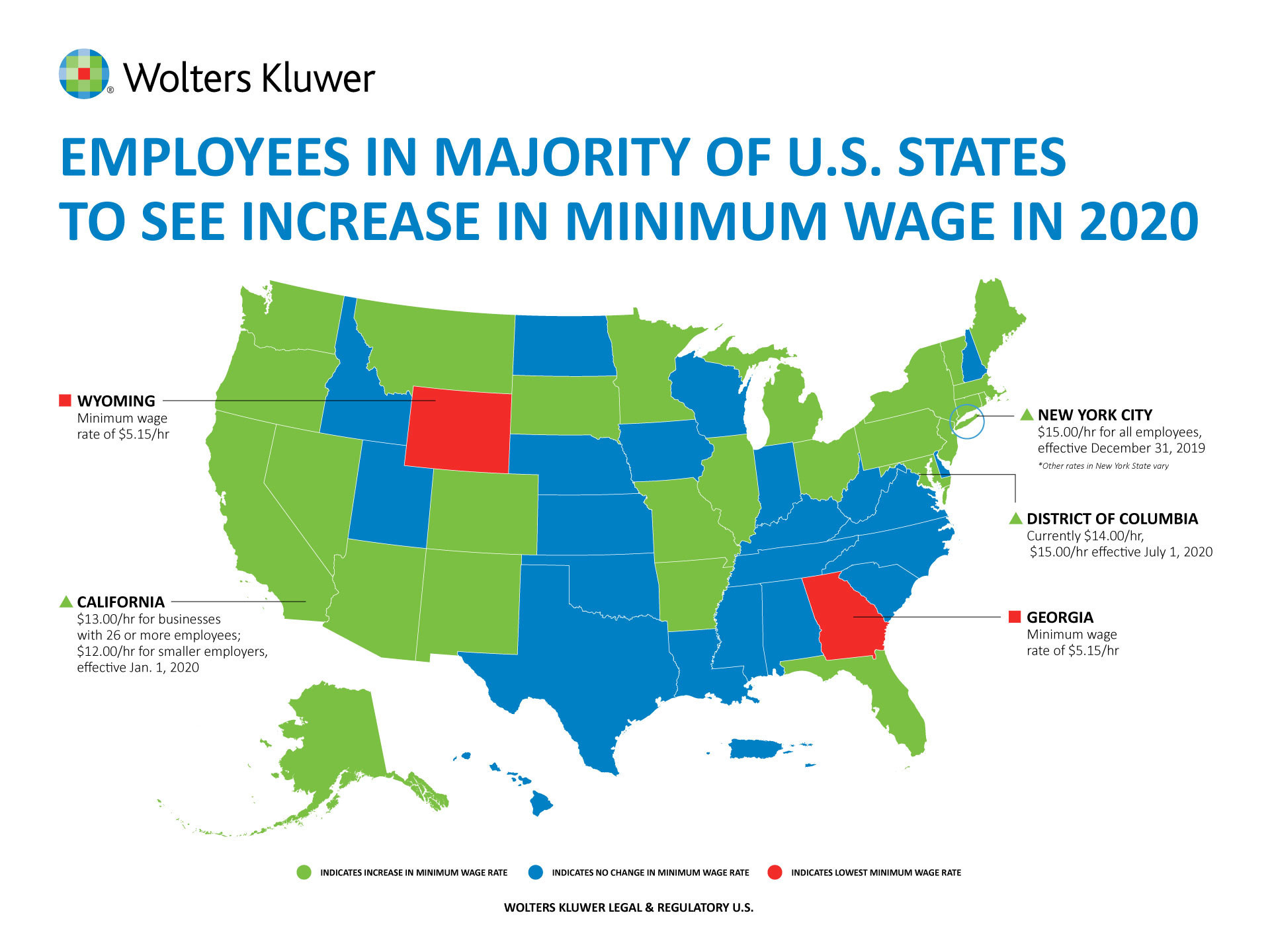Many states across the country are just days away from implementing significant changes in the minimum wage, according to payroll experts Wolters Kluwer Legal & Regulatory U.S. With the clock ticking, a total of 26 states and the District of Columbia will raise the minimum wage in 2020, with 22 of those states implementing the increases by January.

The highest rates in the nation are found at the municipal level. Seattle has the highest minimum wage rate at $16.00 per hour for large employers and $15.00 for small employers. New York City'sminimum wage is set at $15.00 per hour for all employers
California will raise the minimum wage rates by $1 on January 1 ($12.00 per hour for employers with 25 employees or less, and $13.00 per hour for employers with 26 employees or more), while the highest state rate will remain in Washington at $13.50 per hour. A few states' wages remain on the lower end of the spectrum, with some state minimums coming in below the federal wage rate, and others with a slower incremental increase. The lowest minimum wage rates of $5.15 are in Georgiaand Wyoming. However, most employers and employees would be subject to the higher federal minimum wage rate of $7.25 per hour.
"The increases indicate a move toward ensuring a living wage for people across several states," said Barbara O'Dell, JD, an Employment Law Analyst for Wolters Kluwer Legal & Regulatory U.S. "Some of the new rates are the result of previously approved incremental increases to reach a specific amount that is considered to be a living wage such as California, Colorado, Maine, Washington, whereas other states' increases reflect an annual cost-of-living adjustment, such as Alaska, Florida, Minnesota, Montana."
Those states following the step-up approach tend to have higher minimum wage rates than those taking a cost-of-living adjustment approach. The trend towards regional minimum wages, such as those in New York and Oregon, also reflect lawmakers' recognition that costs of living are higher in large metro areas than they are in other parts of the state.
|
Wolters Kluwer Legal & Regulatory U.S. summarizes the states that will be impacted in 2020: |
|
|
Alaska |
$10.19 per hour, up thirty cents from $9.89 per hour, based on a 3% increase in the cost of living. Wage rates are adjusted annually based on inflation. School bus drivers are to be paid two times the minimum wage. |
|
Arizona |
$12 per hour, up from $11 per hour. In addition, employees are entitled to paid sick leave, at the rate of one hour of paid sick time for every 30 hours worked, but with limits based on the size of the employer. |
|
Arkansas |
$10.00, up from $9.25 per hour. The minimum wage will reach $11.00 by 2021. |
|
California |
$13.00 per hour, for businesses with 26 or more employees; $12.00 for smaller employers. On April 4, 2016, California Governor Edmund G. Brown Jr. signed legislation to gradually raise the state minimum wage with annual increases to reach $15 by 2022 for businesses with 26 or more employees and by 2023 for smaller employers. The plan also allows for the Governor to "pause" wage hikes, to be determined by September 1 of each year for the next year, if negative economic or budgetary conditions emerge. |
|
Colorado |
$12.00 per hour, up from $11.10 per hour. |
|
Connecticut |
$11 per hour, scheduled to increase to $12 on September 1, 2020. The minimum wage is scheduled to reach $15 per hour in 2023. |
|
District of Columbia |
$14.00 per hour. The minimum wage is scheduled to increase to $15.00 on July 1, 2020. The minimum wage for tipped employees is $4.45, and is scheduled to increase to $5 per hour on July 1, 2020. Starting in 2021 both wage rates will be adjusted based on inflation. DC Law 21-144 (Act 21-429; B21-712), effective from August 19, 2016 (63 DC Register 11135). |
|
Florida |
$8.56 per hour, up 10 cents, based on a 1.12% increase in the cost of living. Tipped employees must be paid $5.54 per hour, also up 10 cents from the 2019 rate. Wage rates are adjusted annually based on inflation. |
|
Illinois |
$9.25 per hour, up from $8.25. The minimum wage is scheduled to reach $15 in 2025. |
|
Maine |
$12 per hour, up from $11. |
|
Maryland |
Beginning in 2020, the minimum wage is $11, increasing at different increments to reach $15 in 2025 for large employers and in 2026 for small employers. |
|
Massachusetts |
$12.75 per hour, an increase of 75 cents. The minimum wage is scheduled to reach $15.00 by 2023. |
|
Michigan |
$9.65, up from $9.45 per hour. |
|
Minnesota |
$10.00 per hour (up from $9.86) for employees of large employers with an annual gross volume of sales not less than $500,000. Small employers must pay employees a minimum wage of at least $8.15 per hour (up from $8.04). |
|
Missouri |
$9.45, up from $8.60 per hour. The minimum wage will increase by 85 cents per hour each year until 2023, when the state minimum wage will reach $12.00 per hour. |
|
Montana |
$8.65 per hour, up 15 cents, based on a 1.75% change in the cost of living and rounded to the nearest 5 cents. Wage rates are adjusted annually based on inflation. |
|
Nevada |
$8.25 per hour for employees who do not receive health benefits, to increase to $9.00 on July 1, 2020. $7.25 per hour for employees who do receive health benefits applies, to increase to $8.00 eff. July 1, 2020. |
|
New Jersey |
$11.00 per hour for most employees, up from $10.00 per hour. $10.30 per hour for those in seasonal employment, who work on a farm for an hourly or piece-rate wage, or who work for an employer with fewer than six employees. The minimum wage is scheduled to reach $15.00 for most employees in 2024, and for those in seasonal employment, who work on a farm for an hourly or piece-rate wage, or who work for an employer with fewer than six employees in 2026. |
|
New Mexico |
$9.00 per hour, up from $7.50. The minimum wage will increase to $12.00 in 2023. |
|
New York |
Tiered/Rates vary by region: $15 per hour in New York City; $13 per hour in Nassau, Suffolk and Westchester counties (then $1 each year after, reaching $15 on 12-31-2021); $11.80 per hour in remainder of the state (then another .70 each year after until reaching $12.50 on 12-31-2020). The minimum wage for workers in fast food establishments is $15 per hour in New York City and $13.75 per hour in the rest of the state. The minimum wage at all airports (LaGuardia, JFK and Newark Liberty International) is $15.60, and will reach $19 in 2023. |
|
Ohio |
$8.70 per hour, up 15 cents from $8.55 per hour, based on a 1.5% increase in the cost of living. Wage rates are adjusted annually based on inflation. The minimum wage rate applies to employees of businesses with annual gross receipts of $319,000 per year (changed from $314,000 in 2019). For employees at smaller companies and for 14- and 15-year-olds, the state minimum wage is $7.25 per hour, which is tied to the federal rate. |
|
Oregon |
The state minimum wage is tiered, with the highest rate in the Metro Portland area at $12.50 per hour ($13.25 eff. July 1, 2020), the lowest in rural (non-Urban) areas at $11.00 per hour ($11.50 eff. July 1, 2020), and a minimum wage of $11.25 per hour ($12.00 eff. July 1, 2020) in the rest of the state. Scheduled increases per S.B. 1532, L. 2016. |
|
Pennsylvania |
$7.25 per hour, but $12.00 for employees under Governor's jurisdiction. |
|
Rhode Island |
$10.50 per hour per H.B. 5175, L. 2017. |
|
South Dakota |
$9.30 per hour, up 20 cents from $9.10 per hour, based on a 1.7% increase in the cost of living. Wage rates are adjusted annually based on inflation. |
|
Vermont |
$10.96 per hour. This is an 18-cent scheduled increase over the current $10.78 per hour. |
|
Washington |
$13.50 per hour, for employees who have reached the age of 18, per voter-approved Initiative 1433, effective January 1, 2017. The Department of Labor and Industries will resume calculating the minimum wage for calendar years 2021 and beyond, based on increases in the cost of living.
*The above excludes minimum wage rates in Seattle. |














